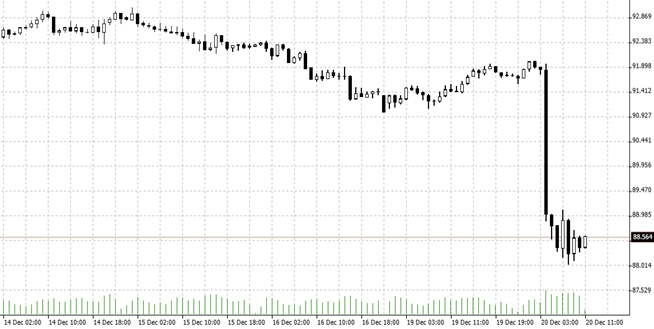

20.12.2022 – Big surprise from the Bank of Japan: Tokyo has made an unexpected change in strategy. The central bank wants to loosen the range in which long-term bond yields move. The market sees this as a first step towards tightening the monetary reins. The yen is gaining significantly.
We could pick USDJPY as the chart for you, but have chosen AUDJPY – because the reaction looks similarly drastic. Here is the hourly chart.

Source: Bernstein Bank GmbH
This is what happened: Until then, the BoJ had always emphasised that it was the only major central bank in the world to maintain its strategy of extremely loose monetary policy to support domestic demand.
Yield cap rises to 0.5 per cent
And now the turnaround. The central bank is sticking to its programme of keeping borrowing costs down. But then the sticking point: the yields of ten-year Japanese government bonds are to be allowed to fluctuate between minus 0.5 percent and plus 0.5 percent in future. The previous range was minus 0.25 per cent and plus 0.25 per cent.
This translates as: The Japanese central bank will now allow a stronger increase in long-term interest rates. The financial blog ZeroHedge commented, “Thus, realistically this is a tightening policy move allowing long-rates to rise from 25bps (the prior YCC limit) to 50bps (the current YCC limit).”
Premature turnaround
Bank of Japan Governor Haruhiko Kuroda caught the financial markets on the wrong foot. Most forex experts had expected a correction of the enormously expansive monetary policy only in spring, because Kuroda’s successor, who has not yet been appointed, will take office then. We are curious to see whether and how the BoJ can contain the interest rate rise at 0.5 per cent. In addition, the question arises whether the currency market will not quickly correct the current violent reaction. Bernstein Bank wishes you successful trades and investments!
__________________________________________________________________________________________
The content of this publication is for general information purposes only. In this context, it is neither an individual investment recommendation or advice nor an offer to purchase or sell securities or other financial products. The content in question and all the information contained therein do not in any way replace individual investor- or investment-oriented advice. No reliable forecast or indication for the future is possible with respect to any presentation or information on the present or past performance of the relevant underlying assets. All information and data presented in this publication are based on reliable sources. However, Bernstein Bank does not guarantee that the information and data contained in this publication is up-to-date, correct and complete. Securities traded on the financial markets are subject to price fluctuations. A contract for difference (CFD) is also a financial instrument with leverage effect. Against this backdrop, CFD trading involves a high risk up to the point of total loss and may not be suitable for all investors. Therefore, make sure that you have fully understood all the correlating risks. If necessary, ask for independent advice. CFDs are complex instruments and are associated with the high risk of losing money quickly because of the leverage effect. 68% of retail investor accounts lose money trading CFD with this provider. You should consider whether you understand how CFD work and whether you can afford to take the high risk of losing your money.7
